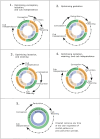When Should 'Clever' Cheetah Breed? Seasonal Variability in Prey Availability and Its Effect on Cheetah Reproductive Patterns
- PMID: 40557125
- PMCID: PMC12185933
- DOI: 10.1002/ece3.71655
When Should 'Clever' Cheetah Breed? Seasonal Variability in Prey Availability and Its Effect on Cheetah Reproductive Patterns
Abstract
Breeding is energetically demanding for female mammals, with maternal and cub nutrition playing a major role in reproductive phases like conception, gestation, lactation and weaning. To meet these demands, adaptations to seasonal shifts in food availability are expected. Some predators may shift prey selection seasonally, optimizing foraging during energetically costly periods. Cheetah, Acinonyx jubatus, prefer adult prey in the dry season when younger prey are scarce but switch to neonate and juvenile prey during the wet season, presumably to optimize foraging during gestation and lactation. Given the wide distribution of cheetah across seasonal (i.e., distinct wet and dry seasons) and aseasonal environments (rainfall throughout the year) and the associated shifts in availability of prey demographic classes, we hypothesized that seasonal prey availability in seasonal systems, but not aseasonal systems, influences the timing of cheetah reproductive phases. Based on the birth dates of cheetahs in seasonal (n = 142) and aseasonal (n = 106) rainfall areas, 58.5% of litters were conceived during the wet season, with 60.6% born in the dry season. In contrast, aseasonal areas showed no seasonality in birth dates. Cheetah reproduction in seasonal environments is driven by the availability of neonate and juvenile prey, with conception and cub independence aligning with peaks in easy-to-catch neonates, while lactation coincides with the availability of larger juveniles. Although cheetahs are often viewed as specialized predators with limited ability to adapt to local environmental conditions, our findings suggest they can adjust reproductive patterns in response to prey availability. This adaptability is important as it will allow cheetahs to successfully raise cubs in the face of changing prey reproductive patterns in response to climate change.
Keywords: breeding season; cheetah; demographic‐specific predation; reproductive phenology; reproductive strategy.
© 2025 The Author(s). Ecology and Evolution published by British Ecological Society and John Wiley & Sons Ltd.
Conflict of interest statement
The authors declare no conflicts of interest.
Figures




References
-
- Anderson, E. M. , and Lovallo M. J.. 2003. “Bobcat and Lynx (<styled-content style="fixed-case"> Lynx rufus </styled-content> and <styled-content style="fixed-case"> Lynx canadensis </styled-content>).” In Wild Mammals of North America, Biology, Management, and Conservation, edited by Feldhamer G. A., Thompson B. C., and Chapman J. A.. John Hopkins University Press.
-
- Barton, K. P. , and Anderson D. R.. 2002. Model Selection and Multimodel Inference: A Practical Information‐Theoretic Approach. 2nd ed. Springer‐Verlag.
-
- Bissett, C. , and Bernard R. T. F.. 2011. “Demography of Cheetahs in Fenced Reserves in South Africa: Implications for Conservation.” African Journal of Wildlife Research 41: 181–191.
-
- Brand, C. J. , and Keith L. B.. 1979. “Lynx Demography During a Snowshoe Hare Decline in Alberta.” Journal of Wildlife Management 43: 827–849.
LinkOut - more resources
Full Text Sources

